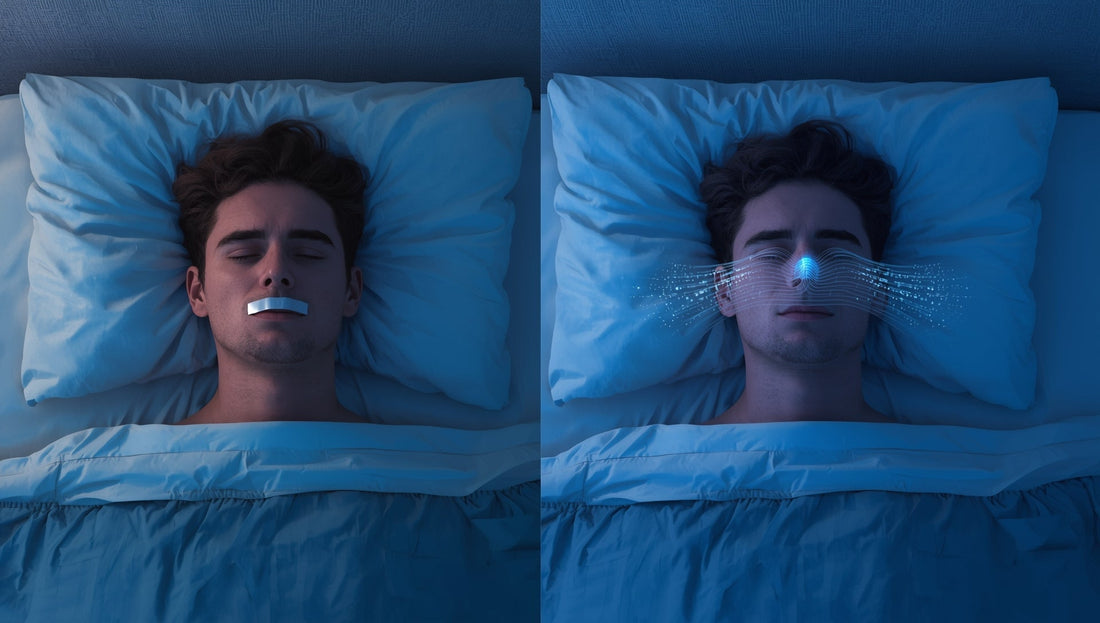Mouth Taping vs. Nasal Breathing: What Really Works for Better Sleep?

A good night's sleep is essential for overall health, yet many people struggle with sleep issues stemming from poor breathing habits. Chronic mouth breathing during sleep can lead to snoring, dry mouth, and lower sleep quality. In the search for solutions, two methods have gained significant attention: mouth taping and conscious nasal breathing.
This post will examine both practices, outlining their benefits, risks, and the science behind them. By understanding each method, you can determine the best approach to improve your breathing and achieve more restful sleep.
What Is Mouth Taping?
Mouth taping is the practice of placing a piece of porous, skin-safe tape over your lips at night to encourage breathing through your nose. The goal is to train your body to default to nasal breathing during sleep, preventing the negative effects of mouth breathing.
Benefits of Mouth Taping
Proponents of mouth taping report several benefits, including:
-
Reduced Snoring: By keeping the mouth closed, taping can reduce the vibrations in the throat that cause snoring.
-
Improved Hydration: It prevents the dry mouth and throat that often result from breathing through your mouth all night.
-
Better Sleep Quality: Nasal breathing can lead to more stable oxygen levels, potentially resulting in deeper, more restorative sleep.
Risks of Mouth Taping
Despite the potential benefits, mouth taping is not without risks and is not suitable for everyone. Potential risks include:
-
Skin Irritation: Adhesive tape can cause irritation or allergic reactions on the sensitive skin around the lips.
-
Breathing Obstruction: If you have severe nasal congestion from allergies or a structural issue like a deviated septum, mouth taping could dangerously restrict your airflow. It's crucial to address any congestion relief needs before attempting this method.
-
Anxiety: For some, having their mouth taped shut can induce feelings of anxiety or claustrophobia.
What Is Nasal Breathing?
Nasal breathing is the natural, intended way for humans to breathe. The nasal passages are specifically designed to filter, warm, and humidify the air before it reaches the lungs. This process optimizes oxygen absorption and protects the respiratory system from irritants.
Benefits of Nasal Breathing
The advantages of nasal breathing are well-documented and include:
-
Air Filtration: Your nostrils act as a natural air purifier, trapping dust, pollen, and other allergens, which helps clear mucus and reduce irritation.
-
Increased Nitric Oxide: The nasal passages produce nitric oxide, a gas that improves the lungs' ability to absorb oxygen and relaxes blood vessels, aiding circulation.
-
Regulated Breathing: Nasal breathing encourages a slower, more controlled breathing rhythm, which can activate the body's relaxation response.
How to Practice Nasal Breathing
Improving your ability to breathe through your nose involves conscious practice and addressing any underlying blockages. If allergy and congestion relief is a concern, consider using an adult nasal suction device or a nasal cleansing system. These tools can help clear your airways, making nasal breathing easier.
The Science: Nasal Breathing vs. Mouth Taping
The primary goal of mouth taping is to force nasal breathing. Therefore, the discussion is less about which method is superior and more about whether taping is a safe way to achieve the established benefits of nasal breathing.
Scientifically, the benefits are rooted in nasal breathing itself. Your nose is a sophisticated filter and humidifier. When you bypass it by breathing through your mouth, you lose these functions. The air reaching your lungs is colder, drier, and contains more irritants, which can lead to inflammation and congestion.
Mouth taping is a tool, not a solution in itself. The true solution is ensuring your nasal passages are clear enough for comfortable breathing.
Practical Tips for Improving Nasal Breathing
Before considering mouth taping, focus on improving your natural ability to breathe through your nose.
-
Address Congestion: Identify the cause of your congestion. For allergies, an effective congestion relief nasal spray or the best nasal rinse machine can make a significant difference.
-
Use a Nasal Cleansing System: A quality nasal irrigation machine is one of the most effective ways to maintain clear nasal passages. Systems like the Clair use oscillating technology to gently remove irritants and mucus in under a minute, providing a simple and effective path to clear breathing.
-
Practice During the Day: Make a conscious effort to breathe through your nose during waking hours. This helps retrain your body and strengthens the habit.
Finding the Right Method for You
At the end of the day, the real key to better sleep isn’t about forcing your mouth shut—it’s about keeping your nasal passages clear so you can breathe naturally and comfortably. While mouth taping may serve as a temporary aid for some, the true long-term solution lies in supporting healthy nasal breathing.
That’s where BreatheClair comes in. Their advanced nasal cleansing systems are designed to gently yet effectively clear out allergens, mucus, and irritants in under a minute, helping you maintain open airways day and night. Unlike quick fixes, BreatheClair’s technology promotes sustainable respiratory health, reducing congestion and supporting deep, restorative sleep without the risks associated with mouth taping.
If you struggle with nighttime congestion, snoring, or restless sleep, adopting a simple daily nasal hygiene routine with a tool like the Clair Nasal Cleansing System can make all the difference. Instead of patching over the problem, you’ll be addressing the root cause—ensuring your breathing is clear, natural, and optimized for better sleep and overall wellness.
Ready to sleep better, breathe easier, and wake up feeling refreshed?
Don’t just patch over the problem—solve it at the source. Visit BreatheClair.com today and subscribe to the Clair Nasal Cleansing System.